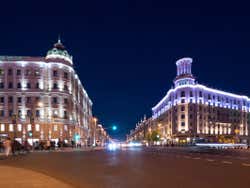
Tverskaya Street
Leading to the iconic Red Square, Tverskaya Street is Moscow's most emblematic avenue and one of the city's most popular shopping areas. It has numerous shops, restaurants and places of interest and is lively at any time of day and night.
A look to the past
With its origins dating back to the 12th century as the main route to the Russian city of Tver (hence its name), Tverskaya Street (Ulitsa Tverskaya, in Russian) has long held importance in Moscow. By the 18th century, it had become the centre of social life and one of the most fashionable areas of the city for the nobility.
After the Bolshevik Revolution, the street underwent major remodelling, with Stalin ordering the demolition of historic buildings, including all five of Tverskaya's churches, to widen the avenue and build modernist high-rises in their place. Some of the buildings were physically moved to new locations further out of the street. Between 1935 and 1990, it was renamed Gorky Street after the Russian writer and revolutionary, before being returned to its former name by Gorbachev.
What to see on Tverskaya Street
Tversakya Street is one of Moscow's main thoroughfares and the mile-long (1.6 km) avenue is home to numerous places of interest. Despite Stalin's best efforts, a number of the street's original buildings still remain, alongside shopping opportunities for every taste. Don't miss the following highlights:
- Hotel National: Built at the beginning of the 20th century, the elegant Hotel National became one of the best hotels of the time thanks to its modern comforts, excellent location and splendid decoration - don't miss the enormous socialist realist style mural atop its façade, an addition during the Soviet era.
- State Duma: A symbol of the immense Soviet power, this concrete mass was built on the remains of an old church and several 17th century buildings that were demolished to make room for the government offices.
- English Club: Located at number 21 is the only palace on the street that has not undergone any reconstruction. In 1831 it became one of the most emblematic buildings in the area when the English Club, an important elite social club, moved in. It currently houses the Museum of Contemporary History of Russia.
- Savvinskoe Podvorye: This beautiful apartment block, built in 1907 with Baroque, Art Nouveau and Russian style architecture, is located at number 6 Tverskaya Street. The mansion survived Stalin's demolition plans and, so they say, the 23,000 ton building was moved 160 feet (50 metres) overnight while its inhabitants slept!
- Government of Moscow: At number 13, you'll find an imposing red building built in 1782 for the general-governor of Moscow. Like its neighbours, this building was also moved 42 feet (13 metres) to allow for the widening of the street.
Moscow's main street
Tverskaya Street was the first avenue to have electric lighting and a pioneer in allowing trams to pass through. It is the street with the most history in Moscow and you're likely to stroll past its impressive monuments several times during your visit to the city.


Transport
Metro: Tverskaya, line 2, Pushkinskaya, line 7, Chekhovskaya, line 9 and Okhotny Ryad, line 1.

